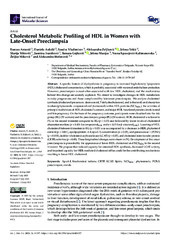Приказ основних података о документу
Cholesterol Metabolic Profiling of HDL in Women with Late-Onset Preeclampsia
| dc.creator | Antonić, Tamara | |
| dc.creator | Ardalić, Daniela | |
| dc.creator | Vladimirov, Sandra | |
| dc.creator | Zeljković, Aleksandra | |
| dc.creator | Vekić, Jelena | |
| dc.creator | Mitrović, Marija | |
| dc.creator | Ivanišević, Jasmina | |
| dc.creator | Gojković, Tamara | |
| dc.creator | Munjas, Jelena | |
| dc.creator | Spasojević-Kalimanovska, Vesna | |
| dc.creator | Miković, Željko | |
| dc.creator | Stefanović, Aleksandra | |
| dc.date.accessioned | 2023-08-09T08:23:33Z | |
| dc.date.available | 2023-08-09T08:23:33Z | |
| dc.date.issued | 2023 | |
| dc.identifier.issn | 1661-6596 | |
| dc.identifier.uri | https://farfar.pharmacy.bg.ac.rs/handle/123456789/4957 | |
| dc.description.abstract | A specific feature of dyslipidemia in pregnancy is increased high-density lipoprotein (HDL) cholesterol concentration, which is probably associated with maternal endothelium protection. However, preeclampsia is most often associated with low HDL cholesterol, and the mechanisms behind this change are scarcely explored. We aimed to investigate changes in HDL metabolism in risky pregnancies and those complicated by late-onset preeclampsia. We analyze cholesterol synthesis (cholesterol precursors: desmosterol, 7-dehydrocholesterol, and lathosterol) and absorption markers (phytosterols: campesterol and β-sitosterol) within HDL particles (NCSHDL), the activities of principal modulators of HDL cholesterol’s content, and major HDL functional proteins levels in mid and late pregnancy. On the basis of the pregnancy outcome, participants were classified into the risk group (RG) (70 women) and the preeclampsia group (PG) (20 women). HDL cholesterol was lower in PG in the second trimester compared to RG (p < 0.05) and followed by lower levels of cholesterol absorption markers (p < 0.001 for campesterolHDL and p < 0.05 for β-sitosterolHDL). Lowering of HDL cholesterol between trimesters in RG (p < 0.05) was accompanied by a decrease in HDL phytosterol content (p < 0.001), apolipoprotein A-I (apoA-I) concentration (p < 0.05), and paraoxonase 1 (PON1) (p < 0.001), lecithin–cholesterol acyltransferase (LCAT) (p < 0.05), and cholesterol ester transfer protein (CETP) activities (p < 0.05). These longitudinal changes were absent in PG. Development of late-onset preeclampsia is preceded by the appearance of lower HDL cholesterol and NCSHDL in the second trimester. We propose that reduced capacity for intestinal HDL synthesis, decreased LCAT activity, and impaired capacity for HDL-mediated cholesterol efflux could be the contributing mechanisms resulting in lower HDL cholesterol. | |
| dc.publisher | MDPI | |
| dc.relation | info:eu-repo/grantAgreement/ScienceFundRS/Ideje/7741659/RS// | |
| dc.rights | openAccess | |
| dc.rights.uri | https://creativecommons.org/licenses/by/4.0/ | |
| dc.source | International Journal of Molecular Sciences | |
| dc.subject | phytosterols | |
| dc.subject | ApoA-I | |
| dc.subject | biochemical indices | |
| dc.subject | CETP | |
| dc.subject | LCAT | |
| dc.subject | lipids | |
| dc.subject | NCSHDL | |
| dc.subject | PON1 | |
| dc.subject | preeclampsia | |
| dc.subject | sterols | |
| dc.title | Cholesterol Metabolic Profiling of HDL in Women with Late-Onset Preeclampsia | |
| dc.type | article | |
| dc.rights.license | BY | |
| dc.citation.volume | 24 | |
| dc.citation.issue | 14 | |
| dc.citation.rank | M21~ | |
| dc.identifier.wos | 001038499500001 | |
| dc.identifier.doi | 10.3390/ijms241411357 | |
| dc.identifier.pmid | 37511116 | |
| dc.identifier.scopus | 2-s2.0-85166009748 | |
| dc.identifier.fulltext | http://farfar.pharmacy.bg.ac.rs/bitstream/id/13620/Cholesterol_Metabolic_Profiling_pub_2023.pdf | |
| dc.type.version | publishedVersion |

